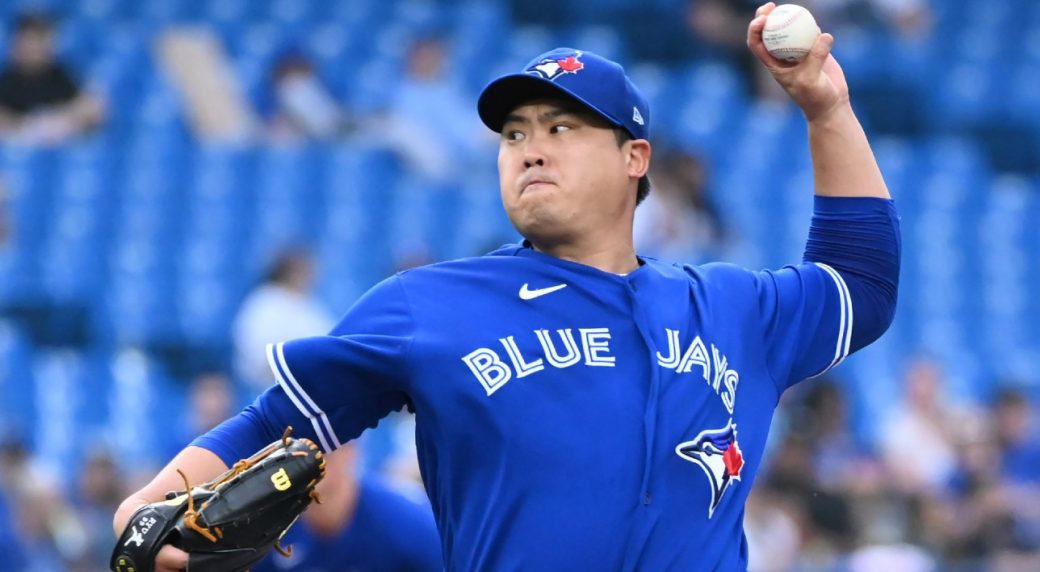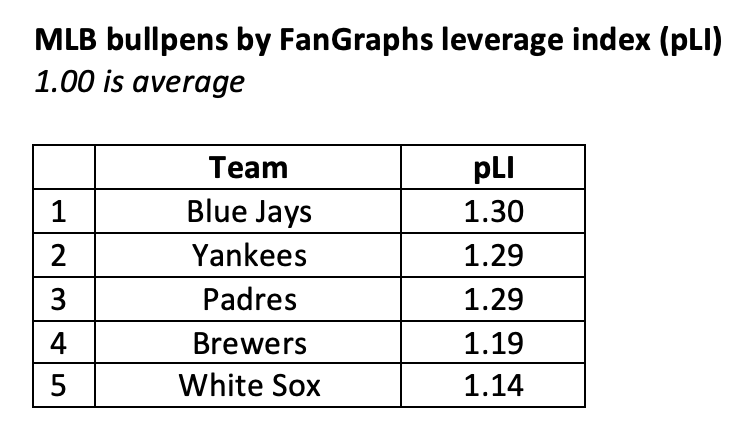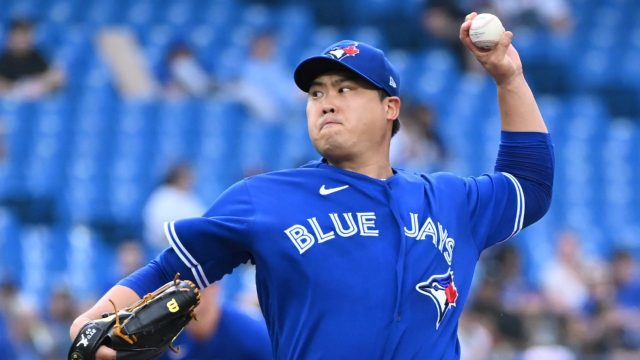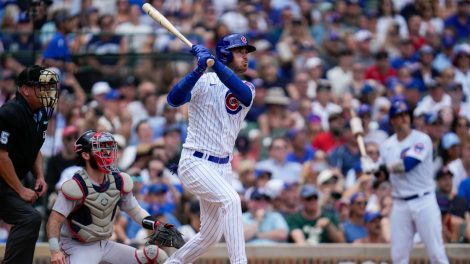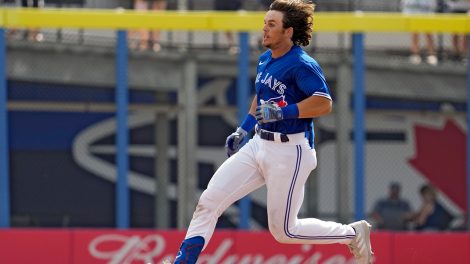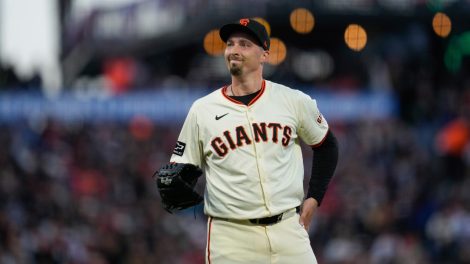TORONTO — David Phelps has pitched for a lot of managers in a lot of places, but one thing that always stuck was how Craig Counsell referred to him and his fellow bullpen-mates during a 2020 stint with the Milwaukee Brewers.
“He called his guys ‘out-getters,’” Phelps remembers. “That’s what our job is. And that’s the exact same mentality we have here. It’s not about having a role. We know Jordan [Romano] has the ninth. But other than that, when the phone rings and your name’s called, you’re ready. Whether it’s the first inning all the way through the ninth.”
Tell us about it. Saturday, Ross Stripling, a swingman who’s spent his career oscillating between starting and long relief, was thrust into a bases-loaded, two-out, ninth-inning spot with a one-run lead and asked to get a save with zero margin for error. Sunday, at the end of an insane, 21-runs-combined afternoon, Phelps was called upon to get his first save in three seasons, and only the seventh of his 10-year career, pitching with — what else? — a one-run cushion.
Tuesday, Julian Merryweather, who’s rarely been trusted to protect slim leads this season and allowed two runs without recording an out in a leverage spot his last time on a mound, was asked to pitch with a one-run lead in the eighth inning. And Trent Thornton — who’d been at triple-A for the prior three weeks — was warming up behind him in case things went awry.
These are the spots the Toronto Blue Jays are finding themselves in with an over-stressed, over-leveraged bullpen that’s carried a massive load through the season’s first two months. Of the 48 games the Blue Jays played entering Wednesday’s clash with the Chicago White Sox, an MLB-high 22 had been decided by one run. It takes a toll.
And thanks to some stellar work from flexible relievers pitching in unfamiliar circumstances, Toronto won 15 of those contests — the same amount of one-run wins it notched in all of 2021. But lately, manager Charlie Montoyo has been running out of options, forced to thrust relievers into situations they either haven’t been successful in before or haven’t commonly faced at all. Hence the “out-getters” mentality.
“We have a lot of guys that can pitch in leverage spots. Which is good, because our entire pen has been in leverage situations pretty much all year,” Phelps says. “But that’s our job. Keep the game where it is so that we either have a chance to come back or we hold the lead. We take a lot of pride in it.”
Wednesday, that meant Phelps entering in the seventh with a runner on and a two-run cushion — what a luxury! — in relief of Stripling, who tossed 2.2 scoreless innings behind Hyun Jin Ryu after he was pulled from his start due to forearm tightness. Things got a little hairy, as Phelps allowed a single and a walk to load the bases for a danger-man in Jose Abreu. But a well-located, 3-1 sinker got Phelps the groundball he needed to escape the jam.
Sending Phelps back out for the eighth after he’d missed the zone with eight of his 12 pitches an inning prior likely wasn’t Montoyo’s first instinct. But on a night when Jordan Romano and Adam Cimber were unavailable, what other choice did he have? So out Phelps came to face the fourth, fifth, and sixth hitters with that two-run lead in the eighth, and wouldn’t you know it, he retired them on nine pitches.
“That was key,” Montoyo said. “Actually, that was maybe the game.”
That set up Yimi Garcia to pitch the ninth, something he’d done only once this season when he coughed up a run in a tie game against the New York Yankees a month ago. Oh, and he’d also pitched on four of the last six days, including a 21-pitch outing Sunday and a 16-pitch one Tuesday. Not exactly how you draw it up. Which is what made this swing by Vladimir Guerrero Jr. in the eighth so huge:
Guerrero’s 10th home run of the season extended Toronto’s lead to four, which might as well be 10 the way this team’s been playing. That allowed Garcia to work with some wiggle room in the ninth, finishing Toronto’s seventh consecutive win — 7-3 over Chicago.
But until that point, it was another night Montoyo and his pitching coach, Pete Walker, spent managing a bullpen atop a tight rope, and it likely won’t be the last one with the club’s next off-day more than a week away. At some point, the leads have to increase or the bullpen has to be bolstered. Maybe both. Because the amount of high-leverage work a small group of relievers is currently absorbing has to be a concern.
Of course, there’s also concern for Ryu, who left his last start after throwing 65 pitches over five innings due to elbow tightness. This time it was 58 over four and forearm tightness. And a number of big, red warning flags along the way.
Ryu sat 87.6 mph with his fastball and 77.8 mph with his changeup, both a 2-mph reduction from his season averages. And he threw only one cutter in the outing, which sat right up over the heart of the plate and was dropped over the left field wall by AJ Pollock.
Several of his diminished fastballs were left up and over the plate, too. Some of his changeups were well located, helping produce five groundouts. But others were not, such as the one Abreu drove 451-feet to left.
“Coming into the game and earlier on, I thought I was going to be able to go out there and just do what I normally do. At the end of it, I noticed that I couldn’t go — I couldn’t carry on any longer. So, I talked with Pete and Charlie about it. We shut it down from then,” Ryu said through interpreter Jun Sung Park. “After going through those innings, I realize I kind of regret playing today’s game.”
From here, Ryu will go for imaging on his arm before next steps are determined. But it wouldn’t be a shock to see him return to the IL, where he spent three weeks in late-April and early-May due to forearm inflammation. Stripling provides a turnkey rotation replacement who can easily slot in and take Ryu’s next turn. Of course, that only further subtracts from a bullpen that can’t afford to lose a serviceable arm right now.
Tim Mayza’s return from a bout of forearm inflammation would certainly help. He felt strong after throwing a bullpen Wednesday and, if he feels good after his next scheduled mound session Friday, could be activated from the injured list without going on a rehab assignment.
Beyond him, there are options at triple-A Buffalo off to strong starts such as Adrian Hernandez, Matt Gage, Brandon Eisert, and Jeremy Beasley. And the Blue Jays have an open 40-man roster spot after designating Ryan Borucki for assignment earlier this week. One way or another, Toronto’s bullpen needs some help. It’s only so long that so few can carry a load so substantial.
Entering Wednesday’s play, no MLB bullpen had faced more leverage than Toronto’s, according to FanGraphs leverage index which accounts for score, bases occupied, outs in an inning, and a situation’s potential impact on win expectancy:
Of the 273 MLB relievers to pitch at least 10 innings this season, five Blue Jays ranked within the top-90 of leverage faced, led by you know who:
“That’s what good teams do,” Phelps says. “Good teams and good bullpens pitch in leverage situations. And they have success doing it. And you look at how many one-run games we’ve played, you look at our record in those one-run games, and I think it just speaks to how well we’ve been doing our job.”
You might not have predicted Phelps’ name to be on that high leverage list a couple months ago, but he’s quietly been an integral, indispensable part of Toronto’s bullpen. He’s often bailed out starters at the end of their outings, or relievers in the midst of jams, and bridged slim leads from the sixth and seventh innings through to the eighth. He entered with runners on base in six consecutive appearances earlier this month and didn’t allow any of them to score.
As he carries an 86th percentile xERA into June, it’s easy to forget Phelps is only a year past major surgery — an invasive and uncommon lat revision procedure that only a handful of major-leaguers have ever undergone. The operation was a necessity for Phelps to continue pitching competitively — but just how competitive he’d be on the other side of it was anything but certain. He reported to Blue Jays spring training this March on a minor-league deal not only trying to prove his value to a big-league bullpen, but first and foremost trying to prove his health.
Phelps did both and flew north with the Blue Jays. But due to a deliberate build-up coming off surgery, and spring training itself being shortened following MLB’s lockout, the 35-year-old didn’t have an opportunity to test himself in games on back-to-back days or even an outing that lasted longer than an inning. Entering the regular season, he still wasn’t sure how his body would respond to that stress.
But then his first appearance of the year lasted 1.1 innings. And four outings later, he was asked to enter games on back-to-back days. And then it was off to the races. Last weekend, he appeared in three of Toronto’s four games against the Angels — and warmed up without entering the other one. He says it was the best his stuff felt all year.
“The ball feels good coming out. From a stuff standpoint, from a standpoint of the way I was attacking people, I think that L.A. series was the closest I’ve been to where I was in the past,” Phelps says. “I think it’s just knowing that my arm’s going to feel good, that it’s going to recover — that’s the biggest thing. Just being able to go out there and trust it.”
Of course, the Blue Jays are still keeping a close eye on his workload. Phelps wasn’t fully, absolutely, not-even-if-there’s-a-fire unavailable Tuesday when the Blue Jays were asking Merryweather and potentially Thornton to face leverage. But after throwing so much volume in California ahead of a cross-continent flight that arrived at 4 a.m. local time Monday, the Blue Jays were determined to only use Phelps if it was absolutely necessary.
Plenty is factored in to those reliever availability decisions, including health history, objective recovery measures, and subjective feedback from the athletes themselves. The club keeps track of not only how many pitches relievers throw in games, but how stressful those pitches are. They also chart high-effort warm-up pitches in bullpens, regardless of whether the reliever touches a game mound or not.
“There are certainly days where you come in and they’re like, ‘You’re down today.’ And you try to plead your case and it’s just, ‘No. Not happening,’” Phelps says. “I think we all realize that we’ve got 162 and, with what our goals are, it’s going to be more than 162. So, they’re just making sure as a full group we’re healthy throughout.”
And if the Blue Jays are going to keep throwing as much leverage at their bullpen as they have been, those decisions will only take on more and more importance. And the out-getters will have to grow more and more accustomed with getting outs in unfamiliar circumstances.
“Nothing’s a surprise for us. Tie game, one-run game, runners on, two outs — we’re used to it by now,” Phelps says. “It’s just going out there and doing our job when we’re called. It doesn’t matter if we’re up 10, down 10, or tied. It’s our job to go out there and put up a zero. That’s our mentality.”

